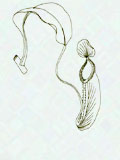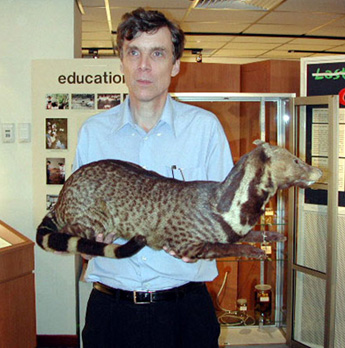

 |
 |
Miscellany
Reintroduction: setting the ball rolling
I have been asked to provide examples of species that I think should be reintroduced (see the front page article). With some reluctance, since I am not an expert on any group of vertebrates, I have done so below, for terrestrial birds and mammals only. To save space, scientific names are given only where the common names are ambiguous. The suggestions are divided into three groups. The Phase 1 species are regionally common species that are already in Hong Kong, in some form, and could be reintroduced now, without any additional research, except into the practicalities of the reintroduction process itself. Phase 2 species all require some additional ecological information, which, in most cases, can probably be obtained from existing sources and the relevant experts. The Phase 3 species are a mixed bag, including some that are probably uncontroversial, others that may need larger forest areas than Hong Kong can currently provide, and some that may never be feasible.
Phase 1Hong Kong’s forest and shrubland fauna includes a number of species which, although probably part of the original native fauna, became locally extinct at some point in the last few hundred years, and have been recently re-established as a result of releases from captivity. These "casual reintroductions" are the best evidence that a formal reintroduction programme would work. Since most of them do not yet occupy all suitable habitats in Hong Kong they also provide ideal candidate species for trying out reintroduction techniques. I suggest that the introduction of the Greater Necklaced Laughingthrush, Streak-breasted Scimitar Babbler and Rufous-capped Babbler to Lantau Island would be a good way to start. The Vinous-throated Parrotbill could probably be added to this list. If these reintroductions were made with stock from the nearest available source in southern Guangdong, it would ensure both that the correct race was established (by no means certain for most of the casual reintroductions) and that the political, legal and logistic problems of translocating animals from wild sources on the mainland were overcome.
Three additional bird species could be included in the first phase without any controversy. The Grey-cheeked Fulvetta is Hong Kong’s most obvious "missing vertebrate" – the commonest forest babbler in the region, but not currently established here, despite scattered releases and occasional evidence of breeding. The Yellow-cheeked Tit is locally established but probably in need of reinforcement, and the Black-throated Tit has a similar status to the Grey-cheeked Fulvetta.
We know our mammals far less well than we know our birds, but one species stands out as an obvious Phase 1 candidate, Pallas’s Squirrel, Callosciurus erythraeus, which is currently represented by two exotic subspecies: C. e. thai, which is widespread on Hong Kong Island, and C. e. styani, which is locally established in parts of the New Territories. The introduction of the "correct" subspecies from southern Guangdong, initially to areas, such as Lantau Island, that currently lack squirrels, would help right an historical error.
Phase 2One bird species stands out as the most attractive Phase 2 reintroduction: the Silver Pheasant. This spectacular pheasant occupies almost all suitable habitats in Guangdong, including the nearest large forest areas to Hong Kong, and there seems to be no reason why it should not thrive here. It is fairly easy to breed in captivity, so the direct translocation of wild individuals would not be essential.
Additional mammalian candidates for early introduction include two twentieth-century extinctions, the Red Fox and the Large Indian Civet, and two species that clearly ought to be in Hong Kong but are currently represented by a very small number of animals of unknown – possibly captive – origin, the Yellow-bellied Weasel and the Yellow-throated Marten. I have relegated these species to Phase 2 only because both quarantine regulations and worries about their potential impact on other species make carnivore reintroductions more difficult. For the Large Indian Civet, which would become Hong Kong’s largest carnivore, there must also be doubts about whether the area of suitable habitat available is sufficient. Other possible Phase 2 mammalian introductions are the Maritime Striped Squirrel, Tamiops maritimus and one of the two Guangdong species of Bamboo Rat.
 |
|
The
author with a Large Indian Civet
|
Phase 3
At this stage, all the candidates for Phase 3 are tentative. My suggestions include the following: Chinese Bamboo Partridge, Rickett’s Hill Partridge, Red-headed Trogon, Black-browed Barbet, Bay Woodpecker (and several other woodpecker species), White-crowned Forktail, Brown Dipper, Mountain Bulbul, Spot-breasted Scimitar Babbler, Brown-capped Fulvetta, Sambar Deer, Southern Serow, Raccoon Dog, Dhole, Hog Badger, Siberian Weasel, Hairy-footed Flying Squirrel, Giant Flying Squirrel (Petaurista philippensis), and Edward’s Long-tailed Giant Rat (Leopoldamys edwardsi). There are many other possible species for which good data currently are lacking. In particular, our forest rodent fauna is extremely impoverished, but detailed distributional information for Guangdong is not available for most potential Phase 3 species.
In the longer term – perhaps the next 50-100 years – I think that the target should be the restoration of as much as possible of the primeval plant and animal diversity of Hong Kong. Since there are neither historical descriptions of what was here in the past, nor an intact baseline community anywhere else in region that can be used as a model, this is going to involve more imaginative extrapolation than many conservationists are currently comfortable with. But can anyone suggest a better alternative?
IUCN/SSC Re-introduction Specialist Group http://iucn.org/themes/ssc/programs/rsg.htm
IUCN/SSC Invasive Species Specialist Group http://www.issg.org/
|
|
P.16-17 |
See also: " The empty forest "
|
Porcupine! |
 Copyright © 2000 |